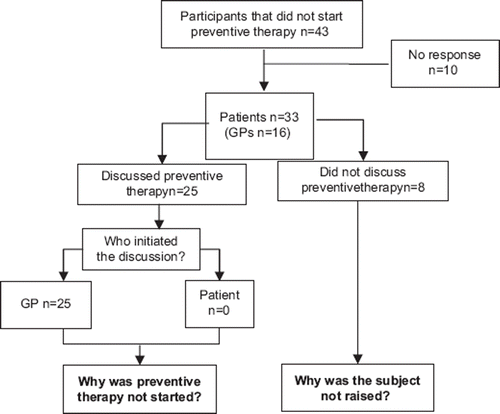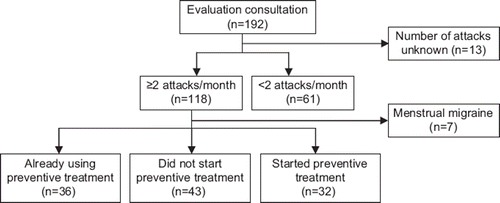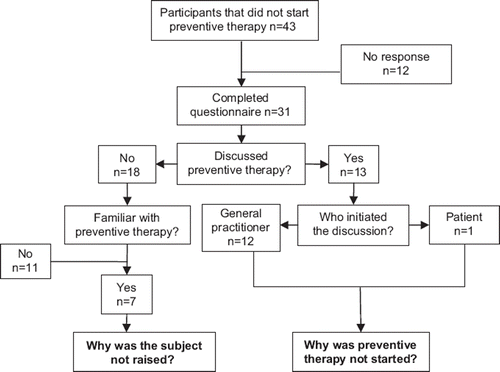Abstract
Background: The number of migraine patients eligible for preventive treatment is considerably higher than the number of patients actually using it. This study explores reasons for this discrepancy. Methods: An explorative survey among patients and their general practitioners (GPs) participating in a trial on preventive medication. Migraine patients who were eligible for preventive treatment (n = 75) attended an evaluation consultation with their GP to optimize migraine treatment. GPs and patients who did not start preventive treatment were asked if they had discussed the possibility of preventive treatment and, if so, why they decided not to start it. Results: Of the 32 GPs, 8 (25%) did not discuss the possibility of preventive treatment with their patients; in 4 because of perceived lack of effectiveness. Patients who did not start preventive treatment (n = 43) used less triptans and had less psychological distress compared to those who did start (n = 32). Main reasons for patients not starting were negative attitudes towards medication in general, fear of medication side-effects, previous unsuccessful attempts, attacks not being severe enough, and impact of migraine on daily life acceptable.
Conclusion: The decision of the individual patient and their GP to start preventive treatment is not only determined by attack frequency, but also depends on the impact of the headache attacks on their daily life and their negative attitude towards medication.
KEY MESSAGE(S):
Only 8-12% of migraine patients uses preventive treatment
The decision to start preventive treatment depends on attack frequency, impact of headache attacks on daily life and attitude towards medication
GPs should pay more attention to the attitudes of patients towards preventive treatment
Introduction
Migraine is a common, disabling headache disorder with lifetime prevalence of 14% (Citation1). In the Netherlands, 25% of women and 7.5% of men experience a migraine attack each year (Citation2). Migraine leads to loss of quality of life and productivity both during and between attacks, causing a high socio-economic burden (Citation3,Citation4). In many guidelines on migraine treatment, a frequency of two or more attacks each month is an important starting point for discussing preventive treatment (Citation5–9). Although ≥ 5% of migraine patients suffer from two or more attacks each month and should be considered for preventive treatment, only 8–12% actually uses it (Citation2,Citation4,Citation10–12). In the Netherlands, over 50% of migraine patients experiencing two or more attacks each month in general practice wishes to try preventive treatment, but have not discussed this with their general practitioner (GP) (Citation12).
This study explores reasons for the discrepancy between the number of patients eligible for preventive treatment and the number of patients actually using it.
Methods
Study group
The study group consisted of migraine patients who participated in the LIMIT study; details on this study are published elsewhere (Citation13). Theoretically, participants may differ from patients in general. However, participants of the LIMIT study did not differ from non participants in terms of age, sex, triptan use at baseline, triptans prescribed during the study period, consultations for headache in the previous year, HIT-6 score, EuroQol score and use of prophylactic medication at baseline or 12 months (Citation13).
The study was approved by the Ethical Committee of the Leiden University Medical Centre. In this pragmatic randomized trial, a proactive approach to migraine patients by their GP was compared with usual care. GPs in the intervention group received two training sessions of three hours each from two specialized GPs. The protocol was based on the headache guideline of the Dutch College of General Practitioners (Citation5). The GP training included diagnostic criteria for headache (migraine, tension-type headache, and medication-overuse headache), acute and prophylactic treatment, and treatment of medication-overuse headache. Patients in the intervention group were invited for an evaluation consultation with their GP to optimize their migraine treatment according to the headache guideline of the Dutch College of General Practitioners. The guideline states that patients who experience two or more headache attacks per month should be offered preventive therapy (Citation5). However, in the LIMIT study 43 (57%) participants, who experienced two or more headache attacks per month according to their headache diary, did not start preventive therapy after this evaluation consultation ().
Characteristics of the study group
The 43 patients who attended the evaluation consultation and reported two or more headache attacks per month, but did not start preventive treatment, were compared with the 32 patients who reported two or more headache attacks per month and did start preventive treatment. The following characteristics were compared: sex, age, impact of headache—using the HIT-6 questionnaire, score range 36 (no headache) to 78 (very severe headache) (Citation14); psychological distress— using the K10 questionnaire, score range 10 (no distress) to 50 (severe distress) (Citation15); number of headache attacks, number of headache days per month, hours of paid work per month, and absence from work (days per month). Data on prescription of triptans and preventive medication, as well as consultation data, were collected from the electronic patient record.
Outcome measures
Patients. Patients were asked to complete a questionnaire about their reasons for not starting with preventive treatment (Supplementary Appendix 1 to be found online at http://www.informahealthcare.com/doi/ejgp/10.3109/13814788.2012.708332). They were asked if they were aware of the possibility of preventive treatment, and if this option was discussed during the evaluation consultation, and who initiated this discussion (patient or GP). In case of not starting prophylaxis, they were asked why they decided not to raise the subject of preventive treatment, or not to start it after having discussed the subject.
GPs. GPs completed a questionnaire on each patient (Supplementary Appendix 1 to be found online at http://www.informahealthcare.com/doi/ejgp/10.3109/13814788.2012.708332). They were asked if they had discussed preventive treatment during the evaluation consultation and who had initiated this discussion. When applicable, they indicated why they had decided not to raise the subject, or decided not to start preventive treatment after having discussed the subject with the patient.
Analyses
Statistical analyses were performed with the SPSS statistical package, using the independent the sample t-test and the Chi-square test in case of dichotomous data.
Results
Starters versus non-starters
presents data on patients starting and not starting preventive treatment. At baseline, patients who did not start preventive treatment used less triptans and had a lower score on the K10 (indicating a lower level of psychological distress). No other differences were found.
Table I. Comparison between migraine patients who did not and those who did start preventive treatment.
Patients
The questionnaire was completed by 31 of 43 patients (72%) (). Responders and non-responders did not differ regarding sex, age, HIT-6 score, K10 score, mean number of triptans prescribed per month during the last year, number of consultations for headache during the last year, number of headache attacks, and number of headache days (data not shown).
Of the 31 responders, 13 (42%) had discussed the possibility of preventive treatment with their GP. In all but one case, the GP initiated the conversation about preventive treatment. Of the 18 patients who did not discuss preventive treatment with their GP, 7 (39%) were aware of the option but did not raise the subject.
The main reason for not raising the subject of preventive medication was that the patient had already tried this in the past (). The main reasons for patients not starting preventive treatment after having discussed the issue with their GP were: a negative attitude against medication in general, fear of side-effects, migraine attacks not being severe enough, acceptable influence of migraine on their daily life, past usage of preventive treatment, and the desire to opt for different treatment first ().
Table II. Reasons given by migraine patients (n = 31) and general practitioners (GPs) (regarding 33 patients) for not discussing, or having discussed but not starting, preventive migraine treatment.
GPs
The questionnaire was completed by 16 GPs with regard to 33 patients (). In 8 cases (24%), preventive treatment was not discussed during the consultation. In all other 25 consultations, the physician raised the subject.
Figure 3. Flowchart of questionnaires completed by the general practitioners (GPs) regarding 33 migraine patients.

The main reason for not raising the subject was that the physician did not expect preventive treatment to have a positive effect on attack frequency or severity (). Other reasons were: attempt to optimize attack treatment first, try alternative treatment first (e.g. physiotherapy), and non-attendance at the follow-up consultation to start preventive treatment. The main reasons for not starting preventive treatment after having discussed the issue with the patient were that patients were content with their present treatment or were not sufficiently motivated for preventive treatment ().
In 4 cases the GP, after having checked the electronic patient record, reported that preventive treatment was discussed, whereas the patient reported that it was not discussed. This suggests recall bias among the patients. In 3 of these 4 cases, the GP reported not to have started preventive treatment because the patient did not want to use medication on a daily basis. In one case, the migraine attacks were not severe enough.
Discussion
Main results
Patients who did not start preventive treatment used less triptans per month compared with patients who started preventive treatment, whereas the two groups did not differ in HIT-6 score, attack frequency, and headache days per month. In addition, patients who did not start preventive treatment had a lower level of psychological distress, which may indicate that their coping with headaches was better and that their wellbeing was less influenced by headaches.
In almost 50% of patients with an indication for preventive treatment, this option was not discussed. When it was discussed, the decision to start actually preventive treatment was mainly influenced by patients’ attitudes towards medication in general, possible side-effects, and the impact of migraine on their daily life. The latter reason is noteworthy, because patients who did not start preventive treatment did not differ from patients who did in score on the HIT-6 questionnaire, attack frequency and headache days. Therefore, the decision regarding whether to start preventive treatment seems to depend more on how patients evaluate their condition than on objective measures.
The main reason for physicians not to discuss the option of preventive treatment was their low expectation of efficacy. When they did discuss preventive treatment, they were often confronted with barriers in the patients themselves.
Study limitations
First, the number of patients is relatively small because it was an explorative study within the setting of a trial. Therefore, we do not claim to give a complete overview of all issues that play a role in decisions on preventive medication. However, this is the first study to ask migraine patients about their reasons for not starting preventive treatment in a natural setting, rather than confronting them with a hypothetical situation (Citation12,Citation16).
Second, the starting point for this pragmatic trial was the number of triptans used, rather than diagnosis of migraine headache. This could have led to the inclusion of participants that did not suffer from migraine headaches, or had a combination of different forms of headache for which preventive treatment was not appropriate.
Third, the results may be subject to recall bias. GPs and patients may have had difficulty in remembering the exact reasons for not starting preventive treatment.
Comparison with other studies
The present study shows that, in addition to migraine characteristics such as duration and frequency, and the impact of the migraine attacks on daily life, also fear of side-effects and a negative attitude towards medication in general play a role in a patient's decision about starting preventive treatment. This corresponds with earlier studies showing that important factors in the decision are effectiveness of an agent, general fear of new interventions on their health problem, fear of side-effects, drug dependency or fear of becoming a chronic patient, involvement in the decision-making process, and the physician taking the time to explain possible side-effects (Citation17–20). Thus, the present study confirms earlier findings, but this time in a ‘real-life’ situation.
The main reason for physicians to discuss not even preventive treatment was their low expectation of efficacy. This corresponds with the findings in a focus group study with GPs that explored ideas, motives and expectations of GPs in relation to preventive treatment of migraine patients (Citation21).
In this study, the main reason for GPs not to start preventive treatment was barriers present in patients. Thus, the patient seems to play the main role in the decision to start or not to start. A study among patients at high risk for cardiovascular disease showed that their willingness to take preventive medication depended more on the mode of communication of treatment benefit than on their actual risk score or their level of concern about a future cardiovascular event (Citation22).
Implications for clinical practice
In patients who seem good candidates for preventive treatment according to their attack frequency, the decision of the individual patient and their GP to start preventive treatment also depends on the impact of the headache attacks on their daily life and their negative attitude towards medication. However, in most guidelines on migraine treatment, as well as in (postgraduate) physician training and patient education, these aspects receive little attention. Therefore, these aspects should be addressed in order to rectify incorrect ideas and remove potential barriers, in both physicians and patients. In addition, as the decision seems to be influenced by the interaction with the GP, physicians should devote sufficient time to a shared decision-making process. Based on these results, we consider that GPs should pay more attention to exploring the attitudes of patients towards medication; providing adequate information about both positive and negative aspects may remove barriers and promote the option of possible effective preventive therapy.
Conclusion
The decision of the individual patient and their GP to start preventive treatment is not only determined by attack frequency, but also depends on the impact of the headache attacks on their daily life and their negative attitude towards medication.
Acknowledgements
The authors thank all patients and physicians who contributed to this research project.
Declaration of interest: The authors report no conflicts of interest. The authors alone are responsible for the content and writing of the paper.
References
- Stovner L, Hagen K, Jensen R, Katsarava Z, Lipton R, Scher A, . The global burden of headache: A documentation of headache prevalence and disability worldwide. Cephalalgia 2007;27:193–210.
- Launer LJ, Terwindt GM, Ferrari MD. The prevalence and characteristics of migraine in a population-based cohort: The GEM study. Neurology 1999;53:537–42.
- Stewart WF, Wood GC, Razzaghi H, Reed ML, Lipton RB. Work impact of migraine headaches. J Occup Environ Med. 2008;50:736–45.
- Lipton RB, Bigal ME. The epidemiology of migraine. Am J Med. 2005;118:3S–10S.
- Knuisting Neven A, Bartelink MEL, De Jongh TOH, Ongering JEP, Oosterhuis WW, Van der Weerd PCM, . NHG-standaard Hoofdpijn. Huisarts Wet. 2004;46:411–22.
- Ramadan N, Silberstein SD, Freitag FG, Gilbert TT, Frishberg BM. Evidence-based guidelines for migraine headache in the primary care setting: Pharmacological management for prevention of migraine; 2000. Available at http://www.neurology.org (accessed 27 January 2012).
- Couturier EGM, Bomhof MAM, Gooskens RHJM, Keyser A, Mulleners WM. Guidelines diagnosis and treatment of chronic recurrent headache (Dutch); 2007. Available at http://www. neurologie.nl (accessed 27 January 2012).
- Evers S, Afra J, Frese A, Goadsby PJ, Linde M, May A, . EFNS guideline on the drug treatment of migraine—revised report of an EFNS task force. Eur J Neurol. 2009;16:968–81.
- British Association for the Study of Headache.Guidelines for all healthcare professionals in the diagnosis and management of migraine, tension-type, cluster and medication-overuse headache; 2007. Available at www.bash.org.uk (accessed 27 January 2012).
- Lipton RB, Bigal ME, Diamond M, Freitag F, Reed ML, Stewart WF. Migraine prevalence, disease burden, and the need for preventive therapy. Neurology 2007;30:343–9.
- Diamond S, Bigal ME, Silberstein S, Loder E, Reed M, Lipton RB. Patterns of diagnosis and acute and preventive treatment for migraine in the United States: Results from the American migraine prevalence and prevention study. Headache 2007;47:355–63.
- Kol CM, Dekker F, Neven AK, Assendelft WJ, Blom JW. Acceptance or rejection of prophylactic medicine in patients with migraine: A cross-sectional study. Br J Gen Pract. 2008;58:98–101.
- Smelt AF, Blom JW, Dekker F, van den Akker ME, Knuistingh NA, Zitman FG, . A proactive approach to migraine in primary care: A pragmatic randomized controlled trial. or Can Med Ass J 2012;184:E224–31.
- Kosinski M, Bayliss MS, Bjorner JB, Ware JE Jr, Garber WH, Batenhorst A, . A six-item short-form survey for measuring headache impact: The HIT-6. Qual Life Res. 2003;12:963–74.
- Donker T, Comijs H, Cuijpers P, Terluin B, Nolen W, Zitman F, . The validity of the Dutch K10 and extended K10 screening scales for depressive and anxiety disorders. Psychiatry Res. 2010;176:45–50.
- Dekker F, Knuistingh Neven A, Andriesse B, Kernick D, Reis R, Ferrari MD, Assendelft WJ. Prophylactic treatment of migraine; the patient’s view, a qualitative study. BMC Fam Pract. 2012;13:13.
- Rozen TD. Migraine prevention: What patients want from medication and their physicians (a headache specialty clinic perspective). Headache 2006;46:750–3.
- Peres MF, Silberstein S, Moreira F, Corchs F, Vieira DS, Abraham N, . Patients’ preference for migraine preventive therapy. Headache 2007;47:540–5.
- Linde M, Jonsson P, Hedenrud T. Influence of disease features on adherence to prophylactic migraine medication. Acta Neurol Scand. 2008;118:367–72.
- Peters M, Abu-Saad HH, Vydelingum V, Dowson A, Murphy M. Patients’ decision-making for migraine and chronic daily headache management. A qualitative study. Cephalalgia 2003;23:833–41.
- Dekker F, Knuistingh Neven A, Andriesse B, Ferrari MD, Assendelft WJJ. Prophylactic treatment of migraine by GPs; a qualitative study. Br J Gen Pract. 2012;62:e268–74.
- Goodyear-Smith F, Kenealy T, Wells S, Arroll B, Horsburgh M. Patients’ preferences for ways to communicate benefits of cardiovascular medication. Ann Fam Med. 2011;9:121–7.


